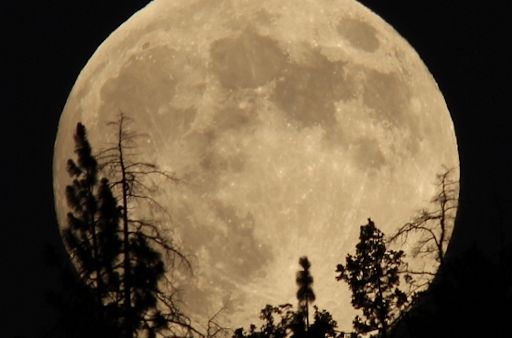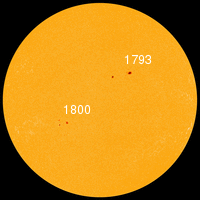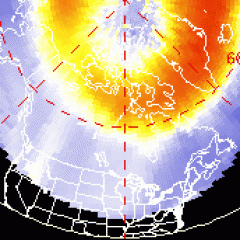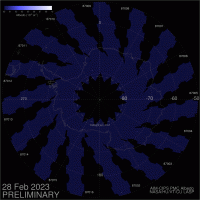QUIET SUN: Solar activity remains low. NOAA forecasters estimate a slim 10% chance that sunspot AR1793 will break the quiet with an M-class solar flare on July 22nd. Solar flare alerts: text, voice.
THUNDER MOON: Picture this: You step outside on a warm summer evening. In the distance, a stroke of lightning plunges to Earth. One-one-thousand, two-one-thousand, three-one-thousand. The air shakes with thunder as the clouds part to reveal a brilliant full Moon. This could happen tonight. According to folklore, the full Moon of July 22nd is the "Thunder Moon", named after the storms of summer. Step outside after sunset and see what happens!
David Hoffmann photographed the waxing Thunder Moon on July 21st from Ashland, Oregon:
"It is always a pleasure watching the moon as she rises through the trees moving slowly into the night sky," says Hoffmann. "This Thunder Moon will be full on July 22nd at 11:17am Pacific time."
Realtime Full Moon Photo Gallery
SPACE WEATHER BALLOON UPDATE: The Petunia-laden payload of the space weather balloon, described below, is being recovered today by a team of hikers from Earth to Sky Calculus. Deep in the Sierra backcountry, they'll be meeting two packers on horseback who are returning the payload from the John Muir Trail. Stay tuned for updates.
PETUNIAS FALL FROM THE EDGE OF SPACE: On Friday, July 19th, Caleb Smith was hiking along the John Muir Trail in California's Sierra Nevada mountains when something unprecedented happened. A vase of petunias parachuted out of the sky. "They landed about 50 feet away from me," he reports. The flowers were returning from the stratosphere, where the students of Earth to Sky Calculus had sent them hours earlier to honor Cassini's historic photography of Earth through the rings of Saturn. Scroll past this pre-launch picture of the petunias to learn more about the mission:
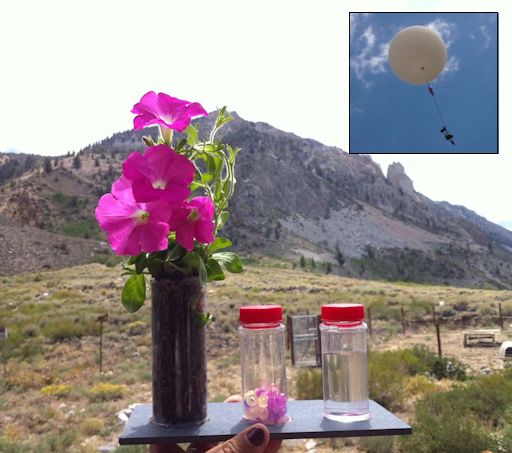
The balloon was launched to photobomb Cassini's picture of Earth from the highest possible altitude. In addition to the petunias, the payload contained three scientific experiments, a copy of the Hitchhikers Guide to the Galaxy, and a Galileo Bobblehead. The items on board were selected competitively from more than 1056 entries suggested by Spaceweather.com readers. First place winners of the competition received free telescopes from Explore Scientific.
The petunias were a bouquet for the ringed planet. It honors Saturn's ancient mythology as a god of agriculture and also makes reference to the Hitchhikers Guide to the Galaxy. Fans of Douglas Adams will understand their significance!
In addition to the items aimed at Saturn, the balloon also carried a space weather experiment. A device combining a GPS altimeter and cryogenic thermometer was sent aloft to measure the height of the tropopause, the coldest layer of Earth's atmosphere. The students who launched the balloon want to see if this changes in response to solar flares and radiation storms.

Solar wind
speed: 401.2 km/sec
density: 3.7 protons/cm3
explanation | more data
Updated: Today at 1557 UT
X-ray Solar Flares
6-hr max: B4 1038 UT Jul22
24-hr: B5 0430 UT Jul22
explanation | more data
Updated: Today at: 1600 UT
![]()
Daily Sun: 22 July 13
Sunspot AR1793 has a beta-gamma magnetic field that harbors energy for M-class solar flares. However, the sunspot is quiet. Credit: SDO/HMI
![]()
Sunspot number: 49
What is the sunspot number?
Updated 22 Jul 2013
Spotless Days
Current Stretch: 0 days
2013 total: 0 days (0%)
2012 total: 0 days (0%)
2011 total: 2 days (<1%)
2010 total: 51 days (14%)
2009 total: 260 days (71%)
Since 2004: 821 days
Typical Solar Min: 486 days
Update 22 Jul 2013
The Radio Sun
10.7 cm flux: 109 sfu
explanation | more data
Updated 22 Jul 2013
![]()
Current Auroral Oval:
Switch to: Europe, USA, New Zealand, Antarctica
Credit: NOAA/POES
![]()
Planetary K-index
Now: Kp= 1 quiet
24-hr max: Kp= 2 quiet
explanation | more data
Interplanetary Mag. Field
Btotal: 6.1 nT
Bz: 1.2 nT south
explanation | more data
Updated: Today at 1557 UT
![]()
Coronal Holes: 22 Jul 13
Solar wind flowing from the indicated coronal hole should reach Earth on July 25-26. Credit: SDO/AIA.
![]()
Spaceweather.com is now posting daily satellite images of noctilucent clouds (NLCs), which hover over Earth's poles at the edge of space. The data come from NASA's AIM spacecraft. The north polar "daisy" pictured below is a composite of near-realtime images from AIM assembled by researchers at the University of Colorado's Laboratory for Atmospheric and Space Physics (LASP). |
![]() Noctilucent Clouds
Noctilucent Clouds
Switch view: Europe, USA, Asia, Polar
Updated at: 07-21-2013 11:55:02

